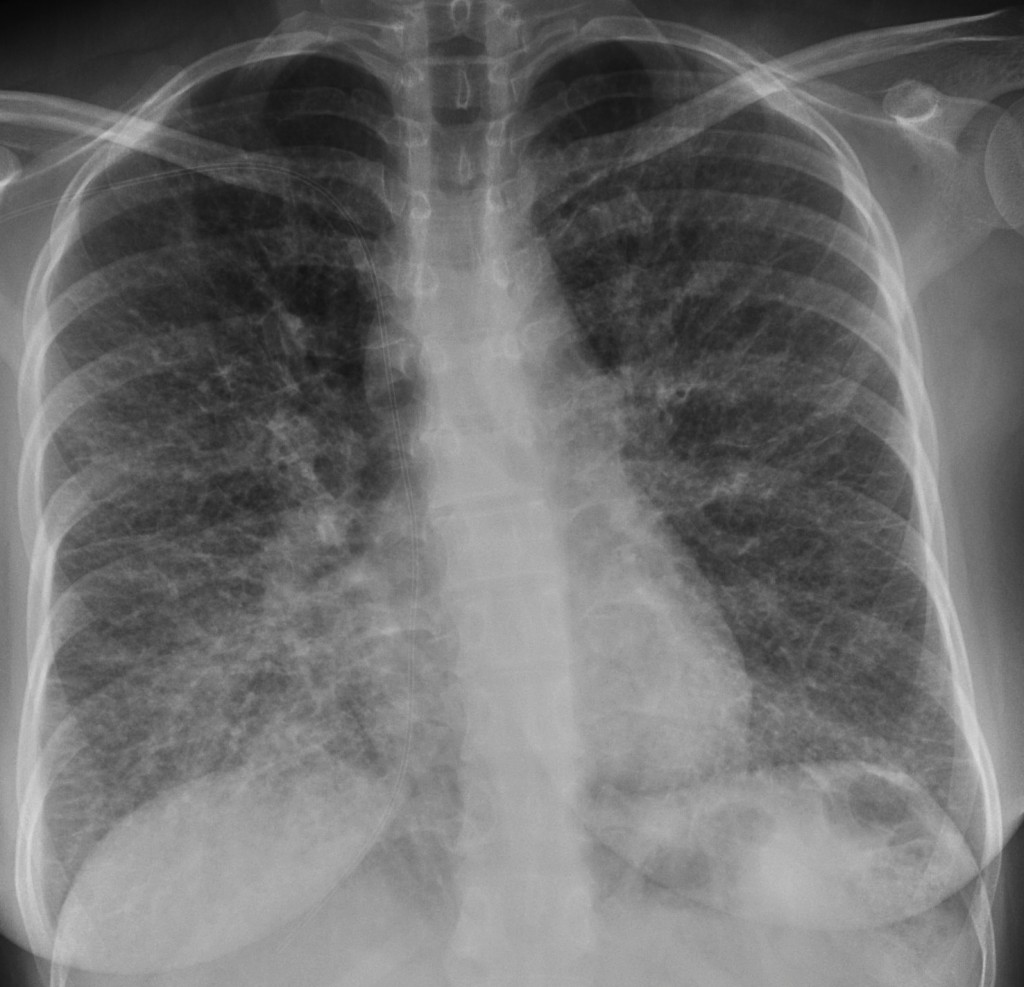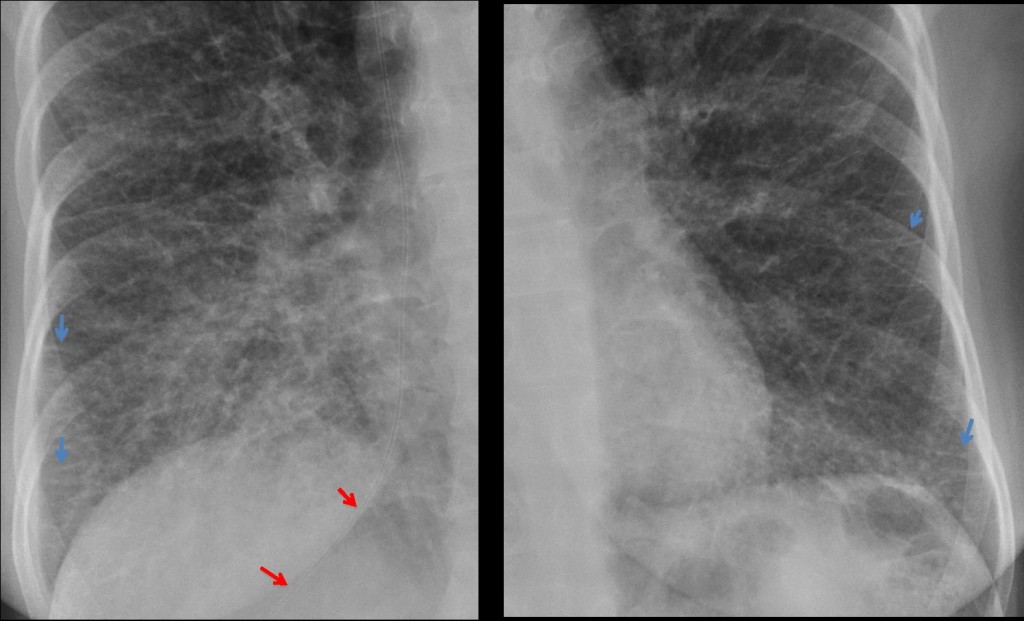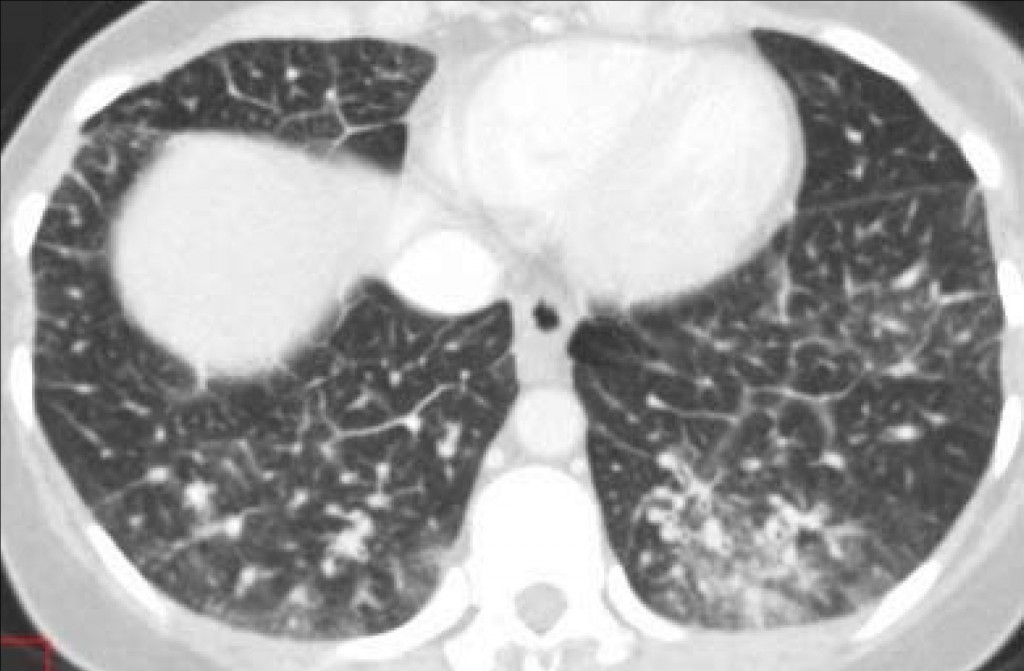
Dear friends,
Muppet saw this case three weeks ago. Clinical history was: 36-year-old woman hairdresser, pre-op chest.
Diagnosis:
1. Sarcoidosis
2. Extrinsic allergic pneumonitis
3. Lymphangitic carcinomatosis
4. Histiocytosis X

36 year old woman, PA chest
Click here for the answer to case #11
This is one of the few cases of diffuse infiltration of both lungs in which the pattern is recognisable. PA chest show the most beautiful Kerley’s lines you will ever see (arrows) identifying a pattern of diffuse lymphangitis.

Patient had a carcinoma of the stomach diagnosed at gastroscopy. The surgeon was not aware of the lymphangitis, which was discovered in the pre-op chest radiograph. Abdominal CT for staging confirmed the lymphangitic spread of the primary tumour.

Incidentally, the venous line ends in the suprahepatic vein. I imagine you all noticed that.
Congratulations to those who made the diagnosis. Muppet hopes that the others will not forget the lesson.
Teaching point: recognising widespread Kerley’s lines in the chest film narrows down the differential diagnosis practically to two entities: cardiac failure and lymphangitic carcinomatosis.






1. Sarcoidosis.
Is the patient asymptomatic? I´ve assumed she is.
Muppet did not have any other clinical information at the time of the reading. He made the diagnosis, though.
Predominantly lower affection, the central venous catheter (by the way, abnormally positioned in a suprahepatic vein )…
I would choose Lymphangitic carcinomatosis.
Congratulations. You are the ony one that mentioned the catheter.
Anyway, I think Pulmonary thesaurismosis induced by inhalation of hair lacqer is extremely rare…but the patient occupation must be an important fact… Mustn’t it Muppet?
Muppet is a simple fellow. He thinks thesaurismosis is the name of a Pharaoh.
or a dinosaur 😉
-reticulonodular opacities involving bilateral mid and lower zones
-no significant volume loss
-suggestion of right paratracheal adenopathy
findings consistent with interstitial lung disease
extrinsic allergic alveolitis and lymphngitis carcinomatosa are top differentials.sparing of upper zones is unlikely in extrinsic allergic alveolitis(only 10%) but occupation makes it likely.
lymphangitis is likely on the basis of central peribronchovascular thickening and nodules,but needs appropriate clinical setting.
HRCT chest for furthur evaluation
Muppet’s too smart. He uses HRCT for really difficult cases.
Extrinsic allergic pneumonitis
Extrinsic allergic pneumonitis. This distribution can be seen early (within hours of exposure). Chronic exposure has an upper and mid zone distribution.
4.
Lymphangitic carcinomatosis
Pre-Op for what? Operation involving her left breast maybe (Ca)?
I will go with lymphagitic carcinomatosis with irregular thickening of septa specially in the middle lobe, assymetric, preserved lung volumes and hilar adenopathy.
Sarcoidosis predominates in mid/upper zones
Langherhans Cell Hystiocytosis usually spares bases and is a mid to upper lobe disease
Extrinsic allergic pneumonitis
Hello Mr. Muppet, does she smoke? If so, then as usual I vote for four 😉
mmm… lymphangitic carcinomatosis :/
lymphantic carcinomatosis
lymphangiitis Ca/Ovarian Cancer,i had a same story patient before a few years…chronic exposure of chemical substances for hair colouring was a couse of it…so,women,take good care when you go to colour your hair 🙂
3
3……or 2!
Patterns of both are different. You have to choose.
Histiocytosis x
does muppet see any changes in the bones?
Muppet does not see any bone changes. But lately he is not himself. I am considering getting himm a seeing-eye dog!
Extrinsic allergic pneumonitis
retculonodular pattern
no rt paratracheal lymph nodes.
3. Lymphangitic carcinomatosis
there normal lung volumes normal lung volumes there is hilar lymph nodes i think this lymphangitis carcinomatosis ,extrinsic allergic pneumnitis and histiocytosis x affect upper lobe most probably
there is no hilar lymphadenopathy
extrinsic allergic pneumonitis
Lymphangitic carcinomatosis